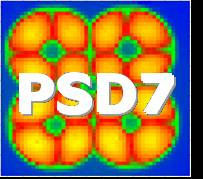Speaker
Mr
Hiroyuki Sekiya
(Kyoto University)
Description
Time Projection Chamber (TPC) has been recognized as a potentially
powerful detector for the WIMPs search by measuring the directions
of nuclear recoils, in which the most convincing signature of WIMPs
caused by the earth’s motion around the Galaxy appears [1]. Since
the energy deposits of WIMPs to nuclei are only a few tens of keV
and the ranges of nuclei are limited, such TPCs should have very
fine special resolutions and should be operated in low pressures.
We are developing a “micro-TPC” based on a gaseous 2D imaging
detector with micro pixel electrodes, “μ-PIC” [2]. The prototype
micro-TPC has a detection volume of 10×10×10 cm3. Normal pressure
gas flow operations show that it possess sufficient ability to
detect the tracks and the Bragg curves (which sense the direction of
tracks) of charged particles with track length of down to 3 mm, and
we expect that the dE/dx threshold of better than 10 keV/cm can be
achieved [2, 3].
Assuming these thresholds of the prototype micro-TPC, it turned out
that 20 torr operation of CF4 and 5 torr operation of Xe are
feasible for WIMPs detection. We describe the first results of the
performance study of the low pressure operation of the micro-TPC
with Ar+C2H6 (90:10). The micro-TPC was put into an aluminum vessel
and operated at 0.2 atm for the first step. It was operated with a
gas gain of 1500 and its stability was checked over 60 hours. Then,
we evaluated its tracking performance with the irradiation of gamma
rays and neutrons from 252Cf . Electron recoils and proton recoils
were clearly separated by plotting the track length as a function of
recoil energy due to the difference of their dE/dx. We could observe
proton tracks and their Bragg curves with energies of as low as
below 100 keV. We also tested 0.2 atm operation with CF4 gas and Xe
gas. These results show that the micro-TPC can provide accurate
measurements of the recoil directions and will have the sensitivity
to the signature of WIMPs.
A larger detection volume (30×30×30 cm3) micro-TPC is now being
developed. We are going to operate it at lower pressures and measure
longer tracks of not only protons but also C, F, and Xe recoils.
References
[1] T. Taniori et al., "Detecting the WIMP-wind via spin-
dependent interaction," Phys. Lett. B, vol. 578, pp. 241-246, 2004.
[2] M. Bouianov et al, "Performance optimization of the micro
pixel chamber", Nucl. Instr. and Meth. A, vol 540, pp.266-272,2005
[3] K. Miuchi et al., "Performance and application of a micro-
TPC," Nucl. Instr. and Meth. A, vol 535, pp. 236-241, 2004.
Primary author
Mr
Hiroyuki Sekiya
(Kyoto University)
